We set up a Clinical Candidate Selection Committee (CCSC), which was a vital part of the EPAD application process. It was not only an evaluation committee but was also the first point of contact with EPAD for intervention owners, and a facilitator of the candidate nomination process. The CCSC:
- Maintained an open and transparent selection process.
- Relied on regulatory authorities to ensure that interventions have met the regulatory requirements to advance to Phase II.
- Supported de-risking the EPAD project by assuring the scientific rationale, safety, and appropriateness of using EPAD to establish PoC for a given intervention.
What were the selection criteria?
All interventions were evaluated against the following nine criteria and rated accordingly.
- Scientific rationale/target validation
- Pharmacokinetics (PK)
- Pharmacology requirements
- Safety
- Plans for full development/regulatory issues
- Develop-ability/CMC quality guidelines
- Biomarkers: assays available for use in the PoC
The PoC master protocol outlines our study design and requirements for all interventions.
EPAD Application Process
The application and access process contained a number of steps but was designed to be as simple as possible.
The EPAD PoC platform was open for expressions of interest from intervention owners including pharmaceutical and biotechnology organisations, academic researchers, and funders.
Before the application process could begin, all parties signed a non-disclosure agreement. The Clinical Candidate Selection Committee (or CCSC) then conducted a scientific review to ensure that the intervention was suitable for EPAD. If approved, an examination of statistical and operational requirements followed.
If all parties agreed, this stage was concluded with the signing of a letter of intent signifying the intervention owner’s commitment to the EPAD PoC.

- Approach: The intervention owner contacted the CCSC via email, or downloads, completed and sent an Expression of Interest to the EPAD PoC team.
- Assess: The CCSC reviewed and identified potentially suitable interventions and had preliminary discussions with the intervention owner. The CCSC provided the template Non-Disclosure Agreement, Nomination Form, and instructions on how to apply, to the intervention owner.
- Submit: All parties signed the Non-Disclosure Agreement and the intervention owner submitted the Nomination Form.
- Review: The CCSC conducted a preliminary review of Nomination Form to determine whether additional experts were needed for the review and the formal CCSC review meeting date was set. If additional experts were required, the intervention owner consented to their involvement.
- Decide: The CCSC review meeting with the intervention owner was conducted and a formal decision was made. Subsequently an operational and statistical review meeting with the PoC team and intervention owner was conducted to determine if their requirements were possible within the EPAD PoC platform.
- Establish: If accepted, the intervention owner signed the Letter of Intent, which triggered the constitution of the Appendix Writing Group. This group was led by the intervention owner and included EPAD representatives. The Letter of Intent included the fees payable by the intervention owner for the scientific, statistical and operational resources required to complete an appendix synopsis.
- Finalise: The Appendix Writing Group worked on their appendix in collaboration with the EPAD team to finalise the study design elements.
- Review: The legal agreements and budget were reviewed per EPAD requirements and approvals received.
- Commence: The Appendix Writing Group reconvened as the Appendix Steering Committee to initiate study start-up activities. Once approvals were received by the sponsor, recruitment from the Longitudinal Cohort Study begins and the trial commenced.

